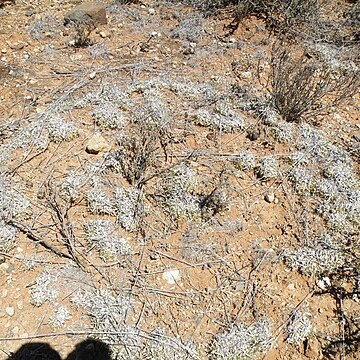Spikelets 3.5–5.5 × (2)2.5–3(3.5) mm, ovate to oblong-ovate, strongly laterally compressed, 5–12(22)-flowered, the florets disarticulating from the apex downwards, the rhachilla fragile; glumes subequal, 1.4–1.9(2.2) mm long, reaching to just beyond the middle of the adjacent lemmas, keeled, lanceolate in profile, scaberulous on the keel, acute at the apex; lemmas 1.7–2.2 mm long, ovate to oblong-elliptic in profile, thinly membranous with hyaline margins and distinct lateral nerves, diverging from the rhachilla at c. 45°, those in opposite rows not imbricate, the rhachilla visible between them, pale green and often tinged with purple, scaberulous on the keel, broadly truncate and slightly retuse at the apex; palea glabrous on the flanks, the keels slender, wingless, scaberulous above; anthers 3, 0.8–1 mm long.
Mat-forming, tufted perennial, up to 400 mm high; forming raised cushions and characteristic rings; rhizome short and branched; basal sheaths with dense, long woolly hairs. Leaf blade (lower) 10-40 x 1.0-1.5 mm (upper blades up to 100 mm long); ligule a fringe of hairs. Inflorescence a panicle. Spikelets 5-7 x 2.5-3.0 mm, completely pallid to flushed with dark purple, laterally compressed; rachilla very fragile, breaking up from apex downwards, florets shed with rachilla internode; glumes shorter than spikelet, 1-nerved. Florets many; lowest lemma truncate, entire, 3-nerved; palea keels scaberulous; anthers 3, 0.8-1.2 mm long. Flowering time Oct.-May.
Perennial; up to 0.4 m high; mat-forming; rhizome short and branched; or tufted; forming raised cushions and characteristic rings. Leaf blades (lower) 10-40 x 1.0-1.5 mm; upper blades up to 100 mm long; basal sheaths with dense; long; woolly hairs. Flowers: panicle contracted; up to 60 mm long; spikelets 5-7 x 2.5-3.0 mm; completely pallid to flushed with dark purple; spikelet rachilla very fragile; breaking up from apex downwards; florets being shed with rachilla internode; lowest lemma truncate; palea keels scaberulous; palea margins wide apart at base; anthers 3; 0.8-1.2 mm long.
Mat-forming perennial; rhizomatous (rhizome short and branched) or tufted (forming raised cushions and characteristic rings); up to 400 mm tall. Leaf blades (lower) 10-40 mm long (upper blades up to 100 mm long); 1.0-1.5 mm wide. Basal sheaths with dense, long, woolly hairs. Spikelets 5-7 mm long, 2.5-3.0 mm wide, completely pallid to flushed with dark purple, spikelet rhachilla very fragile, breaking up from apex downwards, florets being shed with rhachilla internode; lowest lemma truncate; palea keels scaberulous; anthers 3, 0.8-1.2 mm long.
Caespitose mat-forming perennial with short branching rhizomes; culms up to 35 cm tall, erect or ascending, wiry, unbranched, glabrous at the nodes, eglandular; basal leaf sheaths woolly-tomentose, chartaceous, terete, eglandular, persistent; ligule a line of hairs; leaf laminas 0.4–0.6 cm × 1–3 mm, linear to broadly linear, flat or folded, asperulous above, glabrous beneath, rather stiff, glaucous, eglandular.
Panicle 4–6.5 cm long, oblong to elliptic or ovate, loose or dense, the spikelets densely clustered on short secondary branchlets and with short stout pedicels c. 0.5 mm long, the primary branches usually ascending, sometimes appressed to the main axis, rarely spreading, not in whorls, terminating in a fertile spikelet, glabrous in the axils, eglandular.
Caryopsis c. 0.9 mm long, elliptic to oblong-elliptic.

